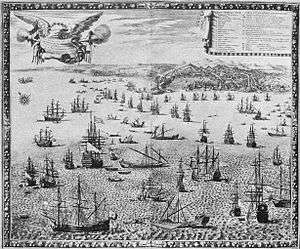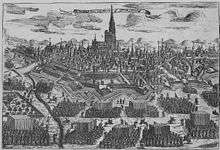War of the Reunions
| War of the Reunions | |||||||
|---|---|---|---|---|---|---|---|
 Bombardment of Genoa | |||||||
| |||||||
| Belligerents | |||||||
|
Dutch militia | |||||||
| Commanders and leaders | |||||||
| Louis XIV | Charles II | ||||||
The War of the Reunions (1683–84) was a short conflict between France and Spain and its allies. It was fueled by the long-running desire of Louis XIV to conquer new lands, many of them comprising part of the Spanish Netherlands, along France's northern and eastern borders. The war was, in some sense, a continuation of the territorial and dynastic aims of Louis XIV as manifested in the War of Devolution and the Franco–Dutch War.
Background
The treaties ending the War of Devolution (the Treaty of Aix-la-Chapelle [1668])[1] and the Franco–Dutch War (the Treaty of Nijmegen [1678]),[2] as well as the Treaty of Westphalia of 1648 (which ended the Thirty Years War), ceded a number of towns to France. By tradition, when a town changed hands, so did the surrounding rural areas, which provided it with food and other such supplies. Often, the borders of these dependent regions were ill-defined. Thus, Louis and his court, from 1670, introduced several Chambers of Reunion to investigate whether France had been granted all the territory that it had been owed. The Chambers of Reunion, loyal to the king, ruled, after a review of conflicting medieval documents, that a number of outlying areas should be awarded to France. They generally consisted of small towns and villages, and for the most part, Louis's annexations went unopposed.

Most territory seized came from the Spanish Netherlands and the western parts of the Holy Roman Empire, especially Alsace. Two of thesell territories seized by Louis as part of the Reunions were Strasbourg and Luxembourg. Officially, Strasbourg was intended to remain a neutral and independent city. However, that left large rural lands under Louis's control that were unprotected by major garrison towns, as Louis' advisors believed that as long as Strasbourg remained independent, Alsace would never be secure from attack.[3] Indeed, the bridge over the Rhine at Strasbourg had been used repeatedly by the Imperial (Holy Roman Empire) forces.[4]
Three times during the recent Franco-Dutch War, Strasbourg had served as a gateway for Imperial invasions into Alsace.[5] Thus, Strasbourg endangered Louis's newly annexed territories in Alsace, just as the great fortress of Luxembourg dominated the other regions Louis had annexed from the Spanish Netherlands. In 1681 Strasbourg, then a so-called independent city in Holy Roman Empire, was annexed after Louis surrounded the city with overwhelming force. Louis marched into the city on 30 September 1681.[6]
Louis also ordered Marshal Louis-François Boufflers to surround and begin an artillery and mortar barrage of Luxembourg.[7]
The summer of 1683 was the peak of War of the Holy League, in which the eastern flank of the Holy Roman Empire went under the greatest ever offensive by Ottoman Empire.[8] The war on the eastern front of the Holy Roman Empire broke the momentum of Louis' confrontation with the Empire over Luxembourg. Louis decided that it would be impolitic for him to attack another Christian kingdom while that kingdom was under attack from the infidel Turk.[7]
Accordingly, in March 1682, Louis ordered a halt to the bombardment of Luxembourg and withdrew his troops.[7] On 12 September 1683, combined Imperial, German and Polish troops defeated the Turks before the walls of Vienna, ending the Turkish threat.[9]
War
As the Ottoman threat stalled before Vienna, the Habsburgs were able to turn their attentions to the west. Luxembourg's resistance to the demands of the French Reunion claims, and its refusal to fall to the French army caused war to break out. Spain declared war on France on 26 October 1683.[10] A French army under the Duke of Humières surrounded the town of Courtrai on the night of 3–4 November 1683.[11] The fortress at Courtrai fell on 6 November 1683. Humières then advanced on Dixmude, which surrendered without a fight on 10 November 1683.[11]
A French army under Marshal François-Joseph, Créqui bombarded Luxembourg with 3,000 to 4,000 mortar shells between 22 and 26 December 1683 and withdrew from the city.[12] However, the real siege of Luxembourg began the next spring when, assisted by his technical expert on siege warfare, Sébastien le Prestre de Vauban, Louis once again surrounded the large fortress at Luxembourg on 29 April 1684.[13] The fortress was defended by 2,500 men and they fought on against the French army until 3 June 1684 when they surrendered.[13] Spanish forces in the Netherlands, backed by the Holy Roman Empire, continued to fight the French, until a final treaty in the war was reached at Truce of Ratisbon on 15 August 1684.[14] France continued to hold all the territory taken during the war, including Strasbourg and Luxembourg.[15] France's subsequent actions taken after the war were intended only to turn the truce into a real, permanent treaty.
Despite its relative brevity, the War of the Reunions developed a reputation for being an especially bloody conflict. Louis XIV and his military advisers designed a campaign of violent reprisals in an effort to influence public opinion, with the aim of pressuring enemy officials to surrender. During one battle Louvois ordered the comte de Montal to burn 20 villages near Charleroi because the Spanish previously destroyed two barns on the outskirts of two French villages, and he insisted that not a single house should remain standing in the 20 villages.[16]
The Republic of Genoa had a long relationship with Spain. Indeed, Genoese bankers and financial houses, the Centurioni, the Palavicini and the Vivaldi families,[17] had, since the 16th century, been lending money to the Spanish government.[18] However, Genoese involvement in the recent war between Spain and France had been rather limited, merely allowing the Spanish to recruit mercenary soldiers on Genoese territory and building some galleys for the Spanish navy.[19] However, even that limited involvement was too much for the French to bear. As a punishment for the indiscretions and for allowing the Spanish troops to use the port at Genoa, a French fleet under the command of Abraham Duquesne sailed from France's great Mediterranean naval base of Toulon to Genoa on 5 May 1684 and began a bombardment of Genoa on 17 May 1684.[20] The bombardment of Genoa lasted for the next 12 days in May 1684[21] with the exception of a reprieve lasting from 22 May until 25 May 1684 to allow for negotiations on a peace to be conducted. When the negotiations broke down, the bombardment resumed and continued until 28 May 1684. In all, the French showered 13,300 bombs on Genoa, destroying about two thirds of the city.[22]
Peace and treaty
While Louis refused to send aid to the Empire and even dispatched secret envoys to encourage the Ottomans, contemporary accounts indicate that it would be unseemly for him to continue fighting the Empire on its western border. Thus, Louis agreed to the Truce of Ratisbon, guaranteeing 20 years of peace between France and the Empire and asking his first cousin, Charles II of England, to arbitrate the disputed border claims.
Aftermath
The war, like its immediate continental predecessors, failed to resolve the festering conflict between the French Bourbon dynasty and the Spanish and Austrian branches of the Habsburg dynasty. The brief but brutal conflict was one of the precursors to the lengthier Nine Years' War.
Notes
- ↑ John A. Lynn, The Wars of Louis XIV: 1667-1714 (Longman Press: Harlow, England, 1999) p. 109.
- ↑ John A. Lynn, The Wars of Louis XIV: 1667-1714, p. 156.
- ↑ John A. Lynn, The Wars of Louis XIV: 1667-1714, p. 164.
- ↑ John A. Lynn, The Wars of Louis XIV: 1667-1714, pp. 163-164.
- ↑ John A. Lynn, The Wars of Louis XIV: 1667-1714, p.169.
- ↑ John A. Lynn, The Wars of Louis XIV: 1667-1714, p. 163.
- 1 2 3 John A. Lynn, The Wars of Louis XIV: 1667-1714, p. 165.
- ↑ Lord Kinross, The Ottoman Centuries: The Rise and Fall of the Turkish Empire (Morrow Quill Paperbacks: New York, 1977) pp. 343-347.
- ↑ Lord Kinross, The Ottoman Centuries: The Rise and Fall of the Turkish Empire, p. 347.
- ↑ John A. Lynn, The Wars of Louis XIV: 1667-1714, p. 166.
- 1 2 John A. Lynn, The Wars of Louis XIV: 1667-1714, p. 167.
- ↑ John A. Lynn, The Wars of Louis XIV: 1667-1714, p. 170.
- 1 2 John A. Lynn, The Wars of Louis XIV: 1667-1714, p. 168.
- ↑ John A. Lynn, The Wars of Louis XIV: 1667-1714, p. 169.
- ↑ Rhea Marsh Smith, Spain: A Modern History a(aUniversity of Michigan Press: Ann Arbor, Michigan, 1965) p. 210.
- ↑ Lynne, John Albert (1993). "How War Fed War: The Tax of Violence and Contributions during the Grand Siècle". The Journal of Modern History. The University of Chicago Press. 65 (2): 301.
- ↑ Hugh Thomas, Rivers of Gold: The Rise of the Spanish Empire from Columbus to Magellan (Random House: New York, 2003) p. 8.
- ↑ Rhea Marsh Smith, Spain: A Modern History, p. 159.
- ↑ John A. Lynn, The Wars of Louis X?IV: 1667-1714, p. 173.
- ↑ John A. Lynn, The Wars of Louis XIV: 1667-1714, p. 174.
- ↑ Lynne, John Albert (2002). The French Wars 1667–1714. Osprey Publishing. p. 48.
- ↑ John A. Lynn, The Wars of Louis XIV: 1667-1714 p. 174.
References
- Lord Kinross, The Ottoman Centuries: The Rise and Fall of the Turkish Empire (Morrow Quill Paperbacks: New York, 1977).
- John A. Lynn: The Wars of Louis XIV 1667–1714, London/New York 1999. ISBN 0-582-05629-2
- Rhea Marsh Smith, Spain: A Modern History (University of Michigan Press: Ann Arbor, Michigan, 1965).
- Hugh Thomas, Rivers of Gold: The Rise of the Spanish Empire, from Columbus to Magellan (Random House, New York, 2003).
- John B. Wolf, The Emergence of European Civilization (Harper & Row Publishers: New York, 1962).